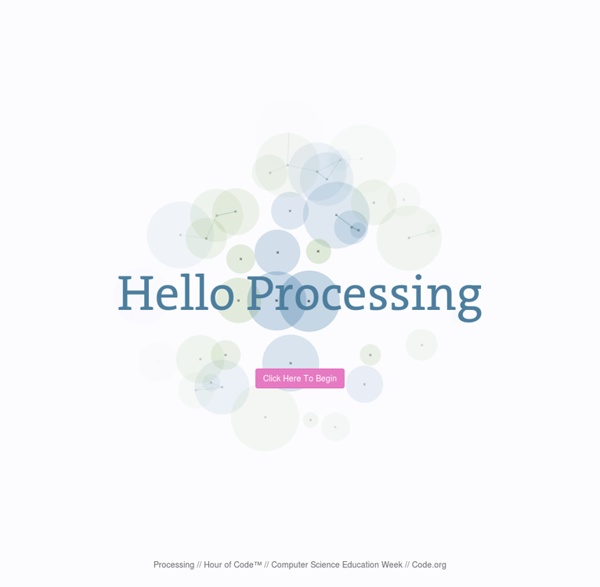



Lightbot : Code Hour on the App Store Codecademy: Hour of Code Hopscotch - Make your own game. Learn to code. Welcome, Inventors! App Inventor is a free, cloud-based service that allows you to make your own mobile apps using a blocks based programming language. You access App Inventor using a web browser (Chrome, Firefox, Safari). With these beginner-friendly tutorials, you will learn the basics of programming apps for Android devices. You will need: A Mac or Windows computer (see system requirements)An internet connection You will make a mobile app, so it's fun to see it run on a phone or tablet while you build the app (and after!). Choose which way you want to connect to run your apps, and follow the links to setup instructions: Android mobile device (phone or tablet) and wi-fiAndroid mobile device (phone or tablet) and a USB cableOn-screen emulator If you hit any snags, we're here to help! Teachers: Get support and tips for preparing for App Inventor hour of code with your students. We have four tutorials to try out for the Hour of Code. For each tutorial, we have multiple ways of accessing them: What's Next?
Teaching Coding (For Teachers who Can't Code) According to a recent study by Code.org, the vast majority of schools in the US do not provide a rigorous computer science curriculum ( One skill that is critically ignored in schools is the actual coding of computers, with many computer science skills focusing instead on office skills like using Microsoft Word and Powerpoint. In fact, 90% of American schools don’t even discuss computer programming! While office skills are necessary, this neglect is a dangerous position for America’s students to be in. According to a recent poll by the US Department of Labor, computer science is one of the most rapidly growing job areas of the last decade, with well over 500,000 new job openings anticipated in the next ten years ( Unfortunately, another thing that schools have been lacking is a supply of skilled teachers with experience in computer programming. So what’s to be done?
Hour of Code Before you can teach, you also need to learn! We've got just the tools for you to jump right in and get your head round coding in LiveCode. We’ve produced 60 short "how to" tutorial videos, all between 3 - 5 minutes long, focused on specific areas of LiveCode. You'll love it. Introduction to LiveCode Skinning and Animation: The Basics Data and Text: Combining Text Graphics and Images: Automated Image Scaling Native-look iOS UIs Data & Text: Compare Lists User Interface Resizing Monitor a Directory Using Touch Messages on Mobile Display a SQL Database Process a Report from Multiple Sources Create a PDF Work with the Clipboard Download HTML or a file Input Validation Line Chart and Vector Manipulation Building Standalone Applications Simple Database Drag and Drop to Import and Export Custom Progress Bar Launch Applications or a Web Browser Word Count & Document Stats Create a Video Thumbnail Index Processing XML Skinning Using Graphics Unicode Text Creating Reuseable Objects Text Editing: Storing Meta Data
CodeQuest - Learn how to Code on a Magical Quest with Games sull'App Store Code.org International champions and gold medalists encourage you to try the Hour of Code. Just give it a try. Code your own sports game at Start learning at Featured athletes: Draymond Green, Olympic Gold Medalist and NBA Champion, Golden State Warriors Serena Williams, Olympic Gold Medalist and Tennis Champion Russell Okung, Super Bowl Champion and NFL player, Denver Broncos Sergio Ramos, World Cup Champion and Soccer/Futbol Player, Real Madrid Sue Bird, Olympic Gold Medalist and WNBA Champion, Seattle Storm Alana Beard, Gold Medalist and WNBA All-Star, Los Angeles Sparks Kobe Bryant, Olympic Gold Medalist and NBA Champion, Los Angeles Lakers Angelo Matthews, Captain of the Sri Lankan Cricket Team Nneka Ogwumike, Gold Medalist, WNBA Champion and 2016 MVP, Los Angeles Sparks Carmelo Anthony, Olympic Gold Medalist and NBA All-Star, New York Knicks Marco Belinelli, NBA Champion, Charlotte Hornets Sarah Quita Offringa, Windsurfing Champion
Kodable Daisy the Dinosaur CodeWeek.it | il sito italiano di CodeWeek.EU Code Avengers Hour of Code This is a free Python, Assembly, C, C++, JavaScript, Java programming app and is good for beginners to learn basic as well as advanced Python, Assembly, C, C++, JavaScript, Java programming. Python, Assembly, C, C++, JavaScript, Java Program are examples presented in a simple and elegant way with compiled Output by our expert Team. This application contains a list of important and useful Python, Assembly, C, C++, JavaScript, Java Programs. This Python, Assembly, C, C++, JavaScript, Java app for android can also be used for studying during exams as well as for interview questions. ------------------------PLEASE NOTE------------------------Instead of giving us a lower rating, please mail us your queries, issues or suggestions. We will be happy to solve them for you :) You cannot run or execute programs with this app. -------------------------------------------Features:-------------------------------------------1. One of the best learning java apps. Excellent ! Awesome. Excellent.
Blockly